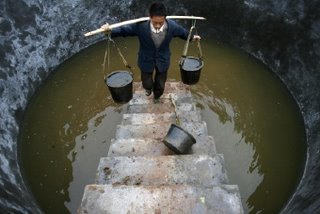Afghanistan's neglected drought
Increasing violence in Afghanistan has overshadowed hardship caused by drought. Christian Aid's Anjali Kwatra writes about the problem in the western province of Herat.
In pictures: Afghan drought
In a graveyard on a hill overlooking the village of Sya Kamarak in western Afghanistan, villagers gathered last week for the funerals of three young children who died of hunger.
They died on the same day from malnutrition caused by a devastating drought that has hit western, northern and southern Afghanistan.
There were no doctors' reports to confirm the cause of death - the parents were too poor to take them to the clinic which is one day's walk away.
Jan Bibi, 40, said she had been feeding her three-month-old daughter Nazia with just boiled water and sugar because she had nothing else.
"My baby died because of inadequate food. I wanted to breastfeed her but I was not producing enough milk."
Jan Bibi's surviving twin daughter Merzia is the size of a newborn rather than a three-month old and cries continually for food.
Dry spell
"I am worried about my baby," said Jan Bibi. "The future is dark because we don't have food or water or fuel for heating. We have to walk for four hours to get to the nearest fresh water - we don't know how we will survive."
Failed crops turn to stocks for burning (Photos: Christian Aid)
The villagers say 50 children have died so far this year - a far higher number than usual - because of the drought.
Almost all the 300 families in remote Sya Kamarak, which is a day's drive along bumpy tracks from the capital of the province, Herat city, live off the land.. Most lost all their wheat harvest when the rains failed in April and May.
A Christian Aid assessment of the drought in five northern and western provinces showed that farmers lost 80-100% of their crops in the worst affected areas and water sources in many villages had dried up.
More at the link above.
~~~~~~~
In pictures: Afghan Drought
Afghanistan's Drought
War has ravaged this country for almost thrity years, and now lack of rainfall is also killing its children. Where is the U.S? Since we too are still in their country after almost five years, what is our responsibility regarding this crisis? Are we going to stand and just watch their children die?
According to the most recent estimates I could find, approximately 12% of the land is arable, but now with drought and extreme soil evaporation that may be less. Permanent pastures average about 46% of the land with about 4% as forests and woodlands which may now also be much less due to deforestation because of remaining forests being cut down to use them for fuel and building materials. Desertification due to dry conditions is also a current environmental issue for Afghanistan as it is for the entire region.

Photo courtesy of NASA.
Dust Storm/Afghanistan/Pakistan
Also see:

Water Management In Central Asia
Would the people of Afghanistan stand up to fight for water? Wouldn't you? I am sure to many Americans and others in this world, the suffering these people in Afghanistan and in this area of the world in general are going through regarding lack of water is incomprehensible.
That needs to change because if we don't change our ways, within the next 45 years more of this world will be a desert, and the water that is left will be the property of those who can afford it and have the power to make it theirs alone.
Australia, China, Afghanistan, Africa...and that is only the beginning. How much of our world will we turn into a wasteland before we realize what we have lost? And if you think the constant dropping of bombs on the land has no effect on the atmosphere nor the conditions in Afghanistan, think again. It isn't only our behavior regarding what we put up in the atmosphere that needs to change, it is also what we rain down.





